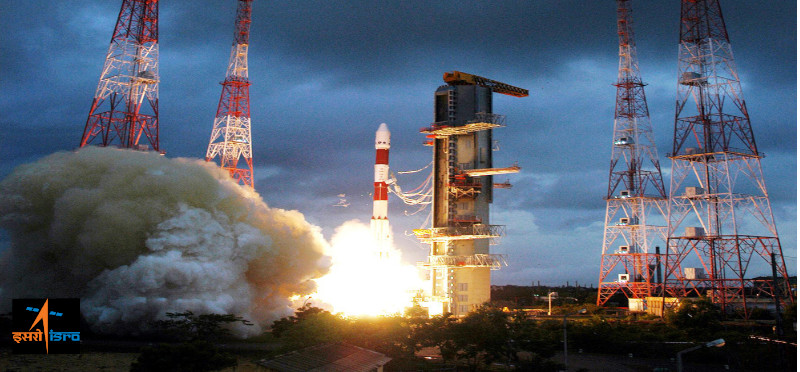
In News
- The Indian Space Research Organisation (ISRO) has set a mid-July date for the launch of much awaited Chandrayaan-2 space mission.
Chandrayaan-2
- This is the second mission from ISRO to send a spacecraft to the Moon.
- The mission also involves a lander and a rover mission.
- ISRO has set July 9 to 16 as the window for launching the mission.
- September 6 is the date for a soft-landing on the moon.
- ISRO has chosen the southern pole of the moon for its lander. This region has not been explored by any space agency so far.
The Payloads
- The mission involves an orbiter, a lander and a rover.
- The orbiter has eight science instruments:
- Terrain Mapping Camera 2 (TMC-2): It provides a detailed 3D map.
- Collimated Large Array Soft X-Ray Spectrometer (CLASS): Maps abundance of major rock forming elements
- Solar X-Ray Monitor (XSM): observes X-rays emitted from sun & supports CLASS
- Orbiter High Resolution Camera (OHRC): Provides high-resolution images of the landing site
- Imaging Infrared Spectrometer (IIRS): Identifies minerals and signatures of hydroxyl and water molecules
- Synthetic Aperture Radar (SAR): Maps lunar craters and other features especially in polar regions
- Chandra’s Atmospheric Composition Explorer (CHACE-2): Will carry out a detailed study of the lunar exosphere
- Radio Anatomy of Moon Bound Hypersensitive Ionosphere and Atmosphere (RAMBHA): Measures Total Electron Content (TEC)
- The Lander has three science instruments:
- RAMBHA (Langmuir probe): Measures TEC of the lunar ionosphere and its morphology. Measures surface plasma density & changes.
- Chandra’s Surface Thermophysical Experiment (ChaSTE): Measures thermal properties of regolith and polar region
- Instrument for Lunar Seismic Activity (ILSA): Measures seismicity of landing site and structure of crust and mantle
- The Rover contains:
- Laser-induced Breakdown Spectrometer (LIBS): Derives chemical composition and infers mineralogical composition on the surface
- Alpha particle X-Ray Spectrometer (APXS): Determines the elemental composition of rocks and soil.
- Apart from these, a passive payload – Retroreflector – from NASA is also a part of the mission.
The Challenges
- As per ISRO, the following are the seven
challenges of landing a probe on the moon:
- Maintaining an accurate trajectory to the moon – the trajectory distance to the moon is 3.844 lakh kilometres. Maintaining the trajectory is dependent on the gravity of the moon which varies in different parts of the moon. Also, there will be the influence of the sun and other astronomical bodies on the spacecraft.
- Deep-Space Communication – there will be a communication delay between the probe and the ground station. This is due to the distance and limited on-board power of the transmitter. A message sent will be received after a few minutes. Also, due to the background noise, the signal becomes weals which must be picked by powerful antennas.
- Trans Lunar Injection and Lunar Capture Mission – In this mission, a series of engine burns will take place to get closer to the Moon whose location keeps changing. The scientists must predict the intersection of the spacecraft and the moon’s path in advance and the margin of error is narrow.
- Orbiting Around Moon – The lunar gravity varies due to the uneven distribution of mass and the spacecraft’s orbit gets influenced. Also, exact knowledge of temperature 100km from the moon is necessary.
- Soft Landing on Moon – ISRO stated that soft landing on the moon is the most challenging part of the Chandrayaan-2 mission. The lander named Vikram must be descended on the moon by adjusting to the local gravity variation. While descending, all systems and units must work in unison. And the lander has to touch down on the rugged terrain gently without any damage or falling into communication shadow area.
- Lunar Dust – the Lunar Dust is very fine, hard and negatively charges. While firing on-board engines, the dust might flow back and stick to the probe leading to disruption in deployment mechanism or functioning of the solar panels.
- Extreme Temperatures and Vacuum – A lunar day or night lasts for 14 Earth days. This causes extreme temperature variations. Ambient pressure of surface is a hard vacuum which makes it a hostile environment for lander and rover.
Mission Facts
- Chandrayaan-2 weighs 3,500 kg.
- It will be launched by GSLV-Mk III rocket.
Conclusion
- The mission if successful will create history and ISRO will yet again prove its mettle in conducting deep space experiments.
Classic IAS Academy : Best IAS Coaching in Delhi, IAS Coaching in Delhi, Top IAS Coaching in Delhi

Leave a Reply
You must be logged in to post a comment.